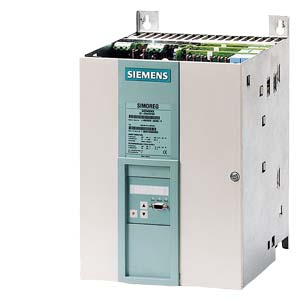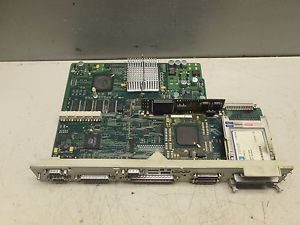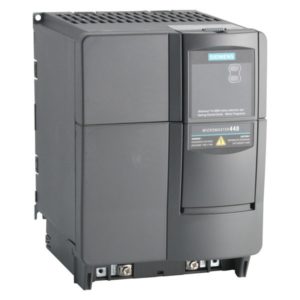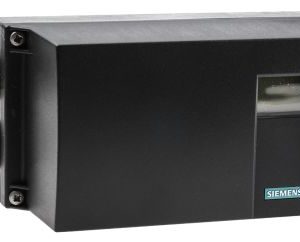SIMOREG DC-MASTER 6RA70 Converters Siemens Drive
Siemens SIMOREG 6RA70 converters are fully digital, compact units for connection to a three-phase AC supply. They in turn supply the armature and field of variable-speed DC drives. The range of rated DC currents extends from 15 A to 3000 A, but can be expanded by connecting SIMOREG converters in parallel.
Description
Power section and cooling
SIMOREG 6RA70 converters are fully digital, compact units for connection to a three-phase AC supply. They in turn supply the armature and field of variable-speed DC drives. The range of rated DC currents extends from 15 A to 3000 A, but can be expanded by connecting SIMOREG converters in parallel.
Converters for single-quadrant or four quadrant operation are available to suit individual applications. As the converters feature an integrated parameterization panel, they are autonomous and do not require any additional parameterization equipment. All open-loop and closed-loop control tasks as well as monitoring and auxiliary functions are performed by a microprocessor system. Setpoints and actual values can be applied in either analog or digital form.
SIMOREG 6RA70 converters are characterized by their compact, space-saving design. An electronics box containing the closed-loop control board is mounted in the converter door. This box also has space to hold additional boards for process-related expansion functions and serial interfaces. This design makes them especially easy to service since individual components are easily accessible.
External signals (binary inputs/output), analog inputs/outputs, pulse encoders, etc.) are connected by way of plug-in terminals. The converter software is stored in a flash EPROM. Software upgrades can easily be loaded via the serial interface of the basic unit.
Power section: Armature and field circuit
The armature circuit is a three-phase bridge connection:
As a fully controlled B6C three-phase connection in converters for single-quadrant drives
As two fully controlled (B6) A (B6) C three-phase connections in converters for four-quadrant drives.
The field circuit is a half-controlled B2HZ single-phase bridge connection.
For converters with 15 to 1200 A
rated DC current, the power section for armature and field is constructed with isolated thyristor modules. The heat sink is therefore at floating potential.
For converters with rated currents ≥ 1500 A, the power section for armature and field is constructed with disc-type thyristors and heat sinks at voltage potential. All connecting terminals for the power section are accessible from the front.
Cooling
Converters with rated DC currents up to 125 A are self-cooled, while converters with rated DC currents of 210 A and higher have forced-air cooling (fan assembly).
Parameterization devices
PMU simple operator panel
All units feature a PMU panel mounted in the converter door. The PMU consists of a five-digit, seven-segment display, three LEDs as status indicators and three parameterization keys.
The PMU is also equipped with connector X300 with a USS interface in compliance with the RS232 or RS485 standard.
The panel provides all the facilities required during start-up for making adjustments or settings and displaying measured values. The following functions are assigned to the three panel keys:
- P (select) key
- Switches over between parameter number and parameter value and vice versa, ack-nowledges fault messages.
- UP key
- Selects a higher parameter number in parameter mode or raises the set and displayed parameter value in value mode. Also selects a higher index on indexed parameters.
- DOWN key
- Selects a lower parameter number in parameter mode or reduces the set and displayed parameter value in value mode. Also selects a lower index on indexed parameters.
- LED functions
- Ready: Ready to operate, lights up in the “Wait for operation enable” state.
- Run: In operation, lights up when operation is enabled.
- Fault: Disturbance, lights up in “Active fault” status, flashes when alarm is active.
The quantities output on the five-digit, seven-segment display are easy to understand, e.g..
- Percentage of rated value
- Servo gain factor
- Seconds
- Amperes or
- Volts
OP1S converter operator panel
The OP1S optional converter operator panel can be mounted either in the converter door or externally, e.g. in the cubicle door. For this purpose, it can be connected up by means of a
5 m long cable. Cables of up to 200 m in length can be used if a separate 5 V supply is available. The OP1S is connected to the SIMOREG via connector X300.
The OP1S can be installed as an economic alternative to control cubicle measuring instruments which display physical measured quantities.
The OP1S features an LCD with 4 x 16 characters for displaying parameter names in plain text. English, German, French, Spanish and Italian can be selected as the display languages. The OP1S can store parameter sets for easy downloading to other devices.
- Keys on OP1S:
- Select key (P)
- UP key 1)
- DOWN key
- Reversing key 1)
- ON key 1)
- OFF key 1)
- Inching key (Jog) 1)
- Numeric keys (0 to 9)
- LEDs on OP1S:
- Green: Lights up in “Run”, flashes in “Ready”
- Red: Lights up with “Fault”, flashes with “Alarm”
- RESET key 1)
Parameterization devices
Parameterization via PC
To allow start-up and troubleshooting using a PC, the DriveMonitor software is supplied with the converters.
The PC is linked to the SIMOREG via the USS interface on the basic unit.
The software provides the following functions:
- Menu-assisted access to parameters.
- Reading and writing of parameter sets.
- Copying of existing parameter sets to other converters of the same type.
- Output of parameter sets to a printer.
- Operation via control words (binary commands such as ON/OFF instructions, etc.) and specification of setpoints.
- Monitoring via status words (checkback information about converter status) and readout of actual values.
- Reading of fault messages and alarms.
- Readout of trace buffer contents (oscilloscope function)
1) This function must be activated with parameters and is freely selectable.
Design
Software structure
Two powerful microprocessors (C163 and C167) perform all closed-loop and drive control functions for the armature and field circuits. Closed-loop control functions are implemented in the software as program modules that are “wired up” via parameters.
Connectors
All important quantities in the closed-loop control system can be accessed via connectors. They correspond to measuring points and can be accessed as digital values. 14 bits (16,384 steps) correspond to 100 % in the standard normalization. These values can be used for other purposes in the converters, e.g. to control a setpoint or change a limit. They can also be output via the operator panel, analog outputs and serial interfaces.
The following quantities are available via connectors:
Analog inputs and outputs
Inputs of actual-value sensing circuit
Inputs and outputs of ramp-function generator, limitations, gating unit, controllers, freely available software modules
Digital fixed setpoints
General quantities such as operating status, motor temperature, thyristor temperature, alarm memory, fault memory, operating hours meter, processor capacity utilization
Binectors
Binectors are digital control signals which can assume a value of “0” or “1”. They are employed, for example, to inject a setpoint or execute a control function. Binectors can also be output via the operator panel, binary outputs or via serial interfaces.
The following states can be accessed via binectors:
Status of binary inputs
Fixed control bits
Status of controllers, limitations, faults, ramp-function generator, control words, status words.
Intervention points
The inputs of software modules are defined at intervention points using the associated parameters. At the intervention point for connector signals, the connector number of the desired signal is entered in the relevant parameter so as to define which signal must act as the input quantity. It is therefore possible to use both analog inputs and signals from interfaces as well as internal variables to specify setpoints, additional setpoints, limitations, etc.
The number of the binector to act as the input quantity is entered at the intervention point for binector signals. A control function can therefore be executed or a control bit output by means of either binary inputs, control bits of the serial interfaces or control bits generated in the closed-loop control.
Switchover of parameter sets
Four copies of parameters with numbers ranging from P100 to P599 as well as some others are stored in the memory. Binectors can be used to select the active parameter set. This function allows, for example, up to four different motors to be operated alternately or four different gear changes to be implemented on one converter. The setting values for the following functions can be switched over:
- Definition of motor and pulse encoder
- Optimization of closed-loop control
- Current and torque
- limitation
- Conditioning of speed controller actual value
- Speed controller
- Closed-loop field current control
- Closed-loop e.m.f. control
- Ramp-function generator
- Speed limitation
- Monitors and limit values
- Digital setpoints
- Technology controller
- Motorized potentiometer
- Friction compensation
- Flywheel effect compensation
- Speed controller adaptation.
Switchover of BICO data sets
The BICO data set can be switched over by the control word (binector input). It is possible to select which connector or binector quantity must be applied at the intervention point. The control structure or control quantities can therefore be flexibly adapted.
Motorized potentiometer
The motorized potentiometer features control functions “Raise”, “Lower”, “Clockwise/Counterclockwise” and “Manual/Auto” and has its own ramp-function generator with mutually independent ramp time settings and a selectable rounding factor. The setting range (minimum and maximum output quantities) can be set by means of parameters. Control functions are specified via binectors.
In Automatic mode (“Auto” setting), the motorized potentiometer input is determined by a freely selectable quantity (connector number). It is possible to select whether the ramping times are effective or whether the output is switched directly through to the output.
In the “Manual” setting, the setpoint is adjusted with the “Raise setpoint” and “Lower setpoint” functions. It is also possible to define whether the output must be set to zero or the last value stored in the event of a power failure. The output quantity is freely available at a connector, e.g. for use at a main setpoint, additional setpoint or limitation.
Only logged in customers who have purchased this product may leave a review.







Reviews
There are no reviews yet.